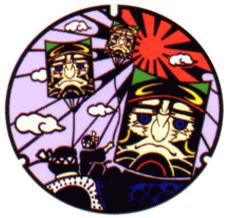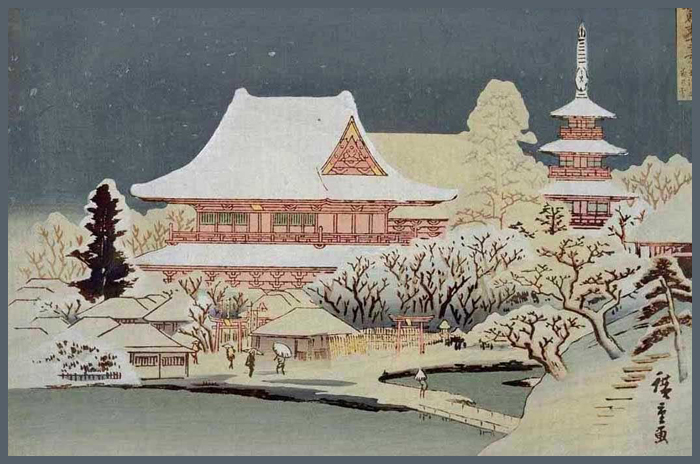. Famous Places and Powerspots of Edo 江戸の名所 .
::::::::::::::::::::::::::::::::::::::::::::::::::::::::::::::::::::::::::::::::::::::::::::::::::::::::::::::::::::::::::::::::::::::::::::::::::::::::::::::::::::::::::::::::::::
Komaba 駒場 "Horse place" district
目黒区 Meguro 駒場 from the first to the fourth sub-district
In the Edo period, it was a wilderness with reed grass and pine trees, called the
Komabano 駒場野 Komaba wilderness
where horses roamed and were kept.
There were also many birds like pheasants and larks, rabbits and wild boars roamed in this place thus suited for hunting.
Around 1720, the Edo Bakufu Government established this area as a hunting ground for the Shogun, especially 将軍吉宗 Yoshimune, who came here 15 times. Since the Shogun was supposed to catch something on a hunting excursion, the villagers kept some prey in cages and let them loose on a hunting day. These villagers were called
tsuna sashi 綱差 rope feeders.
One of these feeders was 川井権兵衛 Kawai Gonbei.
He planted soy beans in a large plot of land. From a hidden hut he observed when the pheasants came to eat the beans. When many had come he pulled a rope with a net and caught them. But very often before the pheasant there came raven and crows to eat the beans, so he had to run through the fields with a long wooden sword to drive them away . . .
When the Shogun came, he cut small wounds in the wings of the birds and let them fly as an easy pray for his lord.
The Kawai family kept this job for some generations.
. Kami-Meguro - The Shogun's Hawk-Hunting Grounds .
The horses for a hunting expedition were kept in this area, hence the name.
In 1932 named as 駒場町 Komaba machi, 1968 named Komaba.
(Part of it belongs to 青葉台四丁目 Aobadai fourth sub-district.)
The famous campus of the 駒場東大 Komaba Todai University is located here.
- quote
a residential neighborhood in the northern area of Meguro, Tokyo, Japan. Consisting of four chōme, the neighborhood has a population of 6,771.
The neighborhood is known as a center for education being the location of a number of selective entry high schools and the Komaba Campus of the University of Tokyo.
- Landmarks
University of Tokyo, Komaba Campus incorporating the Graduate School of Art and Science, the Graduate School of Mathematics, the Institute of Industrial Science Research, and the Research Center for Advanced Science and Technology
Komaba Park, historic 1923 residence and garden estate of the Maeda family.
Japan Museum of Modern Literature (on the grounds of Komaba Park)
Komabano Koen, featuring a municipal sports center and the Kellner Rice Fields
Japan Folk Crafts Museum
National Center for University Entrance Examinations
- MORE in the wikipedia -
..............................................................................................................................................
Koma Koen 駒場公園 Koma Park
目黒区駒場四丁目3番55号
the former residence of the 前田屋敷 Maeda clan from Kaga domain (now Ishikawa prefecture), the living quarters of 前田利為侯爵 Maeda Toshinari (1885 - 1942).

- quote -
Marquis Toshinari Maeda 前田利為侯爵 Maeda Toshinari Kōshaku,
... Maeda's former home built in 1929 in Komaba, Meguro, Tokyo, survives today as the historic centerpiece of Komaba Park.
... In 1957 ownership was transferred to Meguro Ward. Part of the grounds of the estate now host the Japan Museum of Modern Literature.
- - - More in the WIKIPEDIA !
..............................................................................................................................................

駒場野公園 Komabano Koen Park

- CLICK for photos of the University !
- - - - - University of Tokyo, Komaba Campus HP
- reference source : c.u-tokyo.ac.jp... -
..............................................................................................................................................
駒場野 Komabano

広重 Hiroshige II Shigenobu
- quote

江戸名所図絵 Edo Meisho Zue
Komabano, located in the northern part of what is now Meguro Ward,
this picture depicts the area surrounding Komabano, a wide plain that stretched from Yoyogino.
In Edo times, the area boasted large populations of larks, quails, pheasants and rabbits,
and from the Kyōhō era (1716-1736), 495,000㎡of land (some 150,000 tsubo in Japanese)
was used for falconry by the shogunate, with a herb garden also being established in the area.
- source : Tokyo Metropolitan Library -
..............................................................................................................................................
駒場野一揆 Komaba Riot / Uprising

駒場野景色図
嘉永6年(1853年)6月、浦賀に現れた黒船は、天保の改革に失敗し傾きつつあった江戸幕府の土台を、一層揺るがすことになった。開国は、輸出の急速な伸びによる物価騰貴を招き、対外政策における幕府の無力さが人びとを不安にさせた。幕府は、もはや町人や農民の不満を押さえる力をもたなかった。
江戸近郊の野菜の生産地目黒も、時代の動きに無関係ではなかった。農民たちが竹やりを持って、幕府の役人に立ち向かうという事件もあったのである。
.
黒船来航で、遅ればせながら軍事力増強の必要性を痛感した幕府は、フランスにその範を求めた。幕末に、築地など3か所に建てられた講武所には、武術に秀でた者が集められ腕を磨いた。そのけいこぶりは、死者が出るほど激烈なものだった。同時に、フランス人の指導により、西洋式の調練も行われた。
慶応3年5月、
フランス軍事教官シャノワンは、幕府に建白書を提出した。内容は、従来の調練場が手狭なので、大演習や射撃訓練は深川越中島か駒場野でやりたいというものだった。駒場野は、三田村の火薬製造所の火薬を試すにも好都合な場所だった。駒場野は、古くは上目黒村・中目黒村・下目黒村の入会秣場であったが、8代将軍吉宗が鷹場と定めてからは武術訓練の場として使われていた。幕末には軍事教練や砲術訓練がしばしば行われていたので、幕府はこれを拡張しようと計画したのである。
シャノワン
の建白から3か月後の8月、駒場野西方の実地調査が行われた。これは農民にとって寝耳に水の驚きだった。囲い込みとなればなんの補償もなく、農民たちにとって死活問題である。幕府の力が強大なときなら泣き寝入りもしただろうが、農民たちの目にも幕府の衰えは明らかだった。
8月14日、
下北沢村、代田村、幡谷村に実地視察があり、世田谷村羽根木の農家19軒を囲い込むという風聞があった。しかし、事態の詳細は知らされず、なんの補償も示されなかった。不安になった農民たちは仕事も手につかず、寄り集まって今後のことを話し合っていたが、ついに同月20日、駒場野の番人、平助の家を打ち壊すという実力行使にでたのである
農民の抵抗に、
幕府は即、計画を変更して駒場野の東方、上豊沢村、中豊沢村、道玄坂町、下渋谷村へ拡張する方針を決定した。しかし、そこでも農民や町人が断固として抵抗したのである。そのありさまは、世田谷領代官であった大場家の古文書に知ることができる。
「場所御見分可被遊旨被仰出候処、右村町百姓・町人共惑乱竹鎗鉄砲等携口々江群集螺吹鳴シ鯨波ヲ揚相図いたし空砲相発、御出役様方場所御立入相成候ハゝ可及乱妨手筈故同日御見分御見合、追々村役人共より相宥メ漸々昨六日荒増御見置ニ相成」
「駒場原を演習場にするために、
民家200軒余りを取り払うという話は取り止めになったというので一同安心していたが、今度は、駒場原から上・中豊沢村、山(「羽」か)根沢村、道玄坂町、下渋谷町あたりを調査するという。百姓、町人たちは動揺し、竹やり・鉄砲を手に集合してホラ貝を吹き、鬨の声をあげて空砲を撃ち、役人が立ち入ればやっつけるという。それでその日は見合わせ、ようやく6日に調査した」という内容である。周辺十数村の反対にあって、結局、幕府は駒場野拡張計画をあきらめざるをえなかった。
その後、
今度は板橋徳丸ヶ原の拡張を計画したが、これも周辺18か村3,000人の農民らの反対で実現しなかった。大政奉還は、駒場野の一件の2か月後、慶応3年(1867年)10月のことであった。翌年時代は明治に変わり、駒場野はやがて一大軍事基地に変ぼうしたのである。
- reference source : city.meguro.tokyo.jp/gyose... -
::::::::::::::::::::::::::::::::::::::::::::::::::::::::::::::::::::::::::::::::::::::::::::::::::::::::::::::::::::::::::::::::::::::::::::::::::::::::::::::::::::::::::::::::::::
- - - - - H A I K U and S E N R Y U - - - - -
霜解くる町角ばかり駒場町
shimo dokuru machikado bakari Komaba machi
snow melts
in all the street corners
of Komaba city
秋めくと下駄履き出づる駒場駅
. 石田波郷 Ishida Hakyo (1913 - 1969) .
::::::::::::::::::::::::::::::::::::::::::::::::::::::::::::::::::::::::::::::::::::::::::::::::::::::::::::::::::::::::::::::::::::::::::::::::::::::::::::::::::::::::::::::::::::

- - - To join me on facebook, click the image !
:::::::::::::::::::::::::::::::::::::::::::::::::::::::::::::::::::::::::::::::::::::::::::::::::::::::::::::::::::::::::::::::::::::::::::::::::::::::::::::::::::::::::::::::::::::
. Meguro ku 目黒区 Meguro ward .
. Edo bakufu 江戸幕府 The Edo Government .
. Famous Places and Powerspots of Edo 江戸の名所 .
. Doing Business in Edo - 商売 - Introduction .
. shokunin 職人 craftsman, craftsmen, artisan, Handwerker .
. senryu, senryū 川柳 Senryu poems in Edo .
. Japanese Architecture - The Japanese Home .
. Interior Design - The Japanese Home .
. Legends and Tales from Japan 伝説 - Introduction .
[ . BACK to DARUMA MUSEUM TOP . ]
[ . BACK to WORLDKIGO . TOP . ]
- - - - - #komaba #komabano - - - -
::::::::::::::::::::::::::::::::::::::::::::::::::::::::::::::::::::::::::::::::::::::::::::::::::::::::::::::::::::::::::::::::::::::::::::::::::::::::::::::::::::::::::::::::::::



































